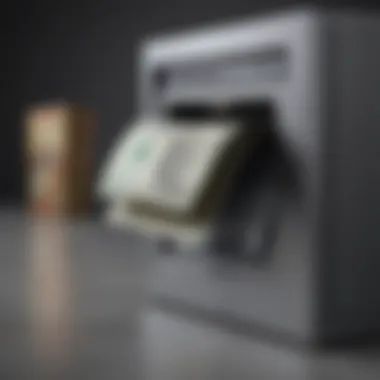Withdrawing Cash from a Credit Card: A Comprehensive Guide


Intro
Withdrawing cash from a credit card, commonly known as a cash advance, presents a unique set of challenges and considerations. This financial maneuver can be attractive for individuals seeking quick access to funds without the lengthy process of traditional loans. However, it is crucial to understand that such transactions come with significant costs and potential ramifications on credit health. This article guides you through the intricacies of accessing cash via your credit card, enabling informed decisions.
Understanding Credit Status
What is Credit Status?
Credit status refers to an individual's creditworthiness, as determined by credit scores and credit reports. This encompasses a financial history that lenders analyze to assess risk when granting credit. Your credit status influences loan approvals, interest rates, and even rental applications.
Key Factors Affecting Credit Scores
Certain elements impact credit scores significantly. These include:
- Payment History: Timely payments improve your score, while late payments hurt it.
- Credit Utilization: High credit utilization can signal financial stress and lower your score.
- Length of Credit History: A longer history can establish reliability in repayment.
- Types of Credit: A diverse mix of credit types can positively affect your score.
- Recent Inquiries: Multiple inquiries for new credit in a short time can lower your score.
Importance of Knowing Your Credit Reports
Understanding your credit report is vital for managing your finances effectively. Your report contains detailed information about your credit accounts, including payment history, outstanding debts, and any public records like bankruptcies. Regularly reviewing your reports helps identify errors or fraudulent activities, affecting your credit standing.
How to Obtain Your Credit Reports
In the United States, individuals are entitled to one free credit report annually from each of the three main credit bureaus: Equifax, Experian, and TransUnion. You can access these reports at AnnualCreditReport.com. It’s advisable to review your reports thoroughly to ensure accuracy and rectify any discrepancies.
Strategies to Improve Credit Score
Effective Methods for Boosting Credit
Improving your credit score often requires consistent effort and discipline. Here are a few effective strategies:
- Pay Bills on Time: Set reminders or automate payments to avoid late fees.
- Manage Credit Utilization: Keep utilization below 30% of your credit limits.
- Avoid Closing Old Accounts: Lengthening credit history positively impacts your score.
Managing Existing Debt
Focusing on existing debt is crucial. You may want to consider consolidation options or systematic repayment plans. Such strategies can significantly ease the burden of multiple payments while improving your score over time.
Importance of Timely Payments
Timely payments directly impact your credit score. Late payments can stay on your report for up to seven years, making it essential to meet your obligations on time. A good payment history establishes trust with lenders and can facilitate better terms in the future.
Utilizing Credit Responsibly
Using credit wisely means avoiding unnecessary debt. Only charge what you can repay in full each month to prevent accruing interest. This habits not only boosts your score but also keeps your finances in check.
Personalized Recommendations for Credit Products
Assessing Your Financial Needs
Identifying your financial needs lays the groundwork for selecting suitable credit products. Take into account your spending habits, income, and overall financial goals.
How Recommendations Work
Recommendations for credit products usually depend on your credit profile, spending patterns, and what products suit your financial health. Financial institutions analyze these factors to propose the best options.
Best Credit Cards for Building Credit
For individuals looking to build credit, options like the Discover it Secured Card or Capital One Platinum Credit Card can provide good starting points. These cards are generally accessible and geared towards improving credit scores.


Ideal Loans for Bad Credit
If you have a low credit score, consider options like personal loans from lenders that specialize in bad credit. Companies like Avant or OneMain can assist those in need of financing despite poor credit.
Actionable Insights and Next Steps
Creating a Personalized Financial Plan
Drafting a financial plan tailored to your unique situation is essential. Outline clear objectives and set manageable timelines to perform financially.
Resources for Continuous Learning
Maintaining financial literacy is a continual process. Resources such as Investopedia, NerdWallet, and forums on Reddit provide a wealth of knowledge and community support.
Importance of Monitoring Your Credit Status Regularly
Regularly tracking your credit status not only alerts you to potential issues but also encourages responsible credit habits. Use tools from sites like Credit Karma or government-approved options for periodic checks.
How to Track Progress and Set Goals
Using financial apps can assist in setting and tracking your goals. Make note of any improvements in your credit score and adjust your strategies accordingly to maintain excellent credit health.
Understanding the implications of withdrawing cash from a credit card goes beyond basic transactions. For many, credit card usage forms an essential part of effective financial management.
Prelude
The act of withdrawing cash from a credit card, often termed a cash advance, is an important financial maneuver that can carry both benefits and risks. Understanding this process is vital for individuals navigating their financial health. It allows access to immediate funds, which can be crucial during emergencies or unexpected expenses. However, it is equally necessary to grasp the potential consequences that follow such a decision.
One key consideration is the cost associated with cash advances. Fees and interest rates may be significantly higher when compared to regular purchases. This aspect cannot be overlooked, as it can lead to unforeseen financial burdens if the cash is not managed appropriately. Furthermore, engaging in cash advances can impact one’s credit score, altering the overall credit utilization ratio. This change can have long-lasting implications for future borrowing and credit health.
This article will explore the mechanics behind cash advances, detailing how individuals can access cash from their credit cards, the fees involved, and strategies for managing this process wisely. By providing a thorough understanding of both advantages and disadvantages, readers can make informed decisions about their financial strategies. Whether in search of quick liquidity or planning for longer-term financial health, knowing the ins and outs of cash advances is essential for anyone with access to credit.
In summary, while withdrawing cash from a credit card can provide immediate relief in financial emergencies, it is crucial that individuals approach this option with caution and a clear understanding of its impact on their financial wellbeing.
Understanding Cash Advances
Understanding cash advances is a crucial aspect when considering the option of withdrawing cash from a credit card. Cash advances can be tempting, especially in urgent financial situations. However, it is essential to grasp their nature, benefits, and risks before proceeding.
A cash advance allows cardholders to access a portion of their credit limit in cash, offering immediate liquidity. This can be beneficial in emergencies or short-term financial difficulties. However, the ease of accessing funds often masks the potential for significant costs and impacts on one's financial health.
In this section, we will outline the basic definition of cash advances and the associated processes, providing insights necessary for informed decision-making.
Definition and Process
A cash advance is defined as a transaction that allows credit cardholders to withdraw cash against their credit limit. This process typically involves using an ATM, bank, or certain retail outlets that offer cash advance services.
The process is straightforward:
- Identify the method of withdrawal. Options include ATMs, bank counters, or checks from your credit issuer.
- Initiate the transaction entering your PIN or presenting your credit card.
- Withdraw the desired amount, keeping in mind your available cash advance limit.
Important Note: The cash advance limit can differ from your overall credit limit. Knowing this figure beforehand is crucial to avoid confusion.
How to Access Cash from Your Credit Card
Accessing cash from a credit card involves a few steps, which are essential for understanding how the transaction works. Here are the main ways to obtain cash:
- ATM Withdrawals: Most credit cards allow cash withdrawals through ATMs. Simply use your credit card and enter your personal identification number (PIN). Make sure your ATM card is linked to your credit card if required.
- Bank Transactions: You can visit your bank branch and request a cash advance by presenting your card. Some institutions may require identification for verification purposes.
- Convenience Checks: Some credit issuers provide checks that can be written to yourself for a cash advance. By depositing these checks, you can access cash directly, but be wary of fees and interest rates.
These methods provide straightforward access to cash. However, understanding the costs associated with cash advances is vital and will be explored further in the next sections.


Fees and Interest Rates
Understanding fees and interest rates is essential when considering a cash advance from a credit card. This section outlines the specific costs associated with this financial move. It is crucial to be aware of these elements to make informed choices and avoid unnecessary debt accumulation. Knowing these expenses helps you plan your finances more effectively and assess whether the cash advance is a sound decision.
Withdrawal Fees
When you obtain cash from a credit card, a withdrawal fee often comes into play. This fee varies depending on the credit card issuer, but it typically ranges from 3% to 5% of the amount withdrawn. Some issuers may also have a minimum withdrawal fee, which can further impact the total cost. For instance, withdrawing $200 could end up costing you $6 if the fee is 3%.
It is also vital to be aware of the transaction method. Using an ATM may carry different fees compared to receiving cash from a bank teller. Always check with your card issuer for specific withdrawal fees to avoid surprises. Here's a summary of key points about withdrawal fees:
- Typically ranges from 3% to 5%.
- May include a minimum fee.
- Varies by transaction type (ATM vs. teller).
Interest Rates on Cash Advances
Interest rates for cash advances generally differ from standard purchase rates. Cash advances typically come with higher interest rates, often exceeding 20% or more. These rates can substantially increase your overall cost if you cannot pay off the advance quickly. Unlike standard purchases, interest on cash advances may start accruing immediately, with no grace period.
It is important to read your card's terms and conditions to understand the specific interest rates that apply. Consider the additional expense that can arise from a cash advance when budgeting, especially since the rates are often higher than for other types of credit usage. Factors to consider regarding interest rates include:
- Higher than average rates compared to purchases.
- Immediate interest accrual without a grace period.
- Significant impact on total debt.
Comparison with Regular Purchases
When evaluating the costs of cash advances, it is beneficial to compare them with regular credit card purchases. Regular purchases generally have lower interest rates and may come with grace periods, allowing users to avoid interest if paid on time. Cash advances, in contrast, lack these benefits and impose immediate fees and higher interest rates.
A comparison may look like this:
| Feature | Cash Advance | Regular Purchase | | Interest Rate | Typically higher, immediate | Usually lower, with grace period | | Fee Structure | Withdrawal fees, varies | Few or no fees | | APR (Annual Percentage Rate) | Often over 20% | Generally under 20% |
Understanding these differences is crucial for effective financial management. Knowing how cash advance fees and interest rates compare to standard credit card use equips borrowers with the necessary knowledge to make prudent financial decisions.
Implications for Credit Utilization
Understanding cash advances is crucial for managing credit effectively. When individuals withdraw cash from their credit card, it affects their credit utilization, which is a significant factor in determining credit scores. Credit utilization measures how much of the available credit a person is using at any given time. High utilization can signal risk to lenders, potentially leading to impacts on credit scores and borrowing ability.
Impact on Credit Score
When using a credit card for cash withdrawals, the credit utilization ratio increases. This ratio is calculated by dividing the total outstanding balances by the total credit limits. For example, if a person has a $5,000 limit and withdraws $1,000 in cash, their utilization rises to 20%. This could negatively impact their credit score, especially if the balance remains high over time.
Monitoring credit utilization is vital. Keeping it below 30% is advisable for maintaining a healthy score. Regularly withdrawing cash or accumulating high balances can lead to higher ratios, diminishing trust from lenders. Consequently, individuals should be mindful of how cash advances influence their credit score.
Key Point: Keeping credit utilization low helps maintain a high credit score, which is essential for future borrowing opportunities.
Debt-to-Income Ratio Considerations
A cash advance can also affect one’s debt-to-income (DTI) ratio. The DTI ratio compares monthly debt payments to gross monthly income. Higher debt levels, from cash advances, can raise the DTI ratio, indicating a larger portion of income is directed towards debt repayment.
Lenders often evaluate the DTI ratio when approving loans. A high DTI ratio may signal potential financial strain, leading to more scrutiny during loan applications. Thus, responsible management of cash advances is important to avoid complications in future borrowing opportunities.
In summary, it is essential to grasp the implications of cash advances on credit utilization. A balanced approach is necessary for financial health, ensuring that credit scores remain favorable and debt levels do not overwhelm personal finances.
Alternative Options to Cash Advances
While cash advances from credit cards provide quick access to funds, they can come with significant costs and consequences. Therefore, exploring alternative options can be a smarter financial move. This section highlights the importance of understanding these alternatives, emphasizing their benefits and considerations over cash advances.
Personal Loans
Personal loans are an appealing option for individuals looking to meet short-term financial needs without resorting to credit card cash advances. Banks and credit unions typically offer personal loans with fixed interest rates, which can make repayment more manageable. The process to obtain a personal loan often requires some paperwork including income verification and credit checks. Interest rates on personal loans can vary widely, but they tend to be lower than those associated with cash advances. Furthermore, personal loans usually have defined repayment terms, which can help borrowers budget effectively.
Home Equity Lines of Credit (HELOC)


A Home Equity Line of Credit, or HELOC, is an alternative that allows homeowners to borrow against the equity in their property. This option is beneficial for those who have built sufficient equity and need access to larger sums of money. With HELOCs, interest rates are often lower than what is found with cash advances. Moreover, funds can be drawn as needed, providing flexibility. It's important to bear in mind that using a HELOC involves borrowing against home equity. This means failing to repay could result in losing the home. Thus, thorough considerations and financial planning are critical when contemplating HELOCs.
Borrowing from Friends or Family
Another alternative is borrowing from friends or family. This can sometimes be the least expensive option, as it often comes with no interest attached. Additionally, the repayment terms can be more flexible compared to formal loans. However, this method does come with its own set of challenges. Mixing finances with personal relationships carries risks. If repayment issues arise, it could affect the relationship negatively. Proper communication about terms and expectations is essential here to avoid potential conflicts.
Exploring these alternative options provides a broader understanding of financial resources, allowing individuals to make informed choices that align with their long-term financial health.
In summary, although cash advances can seem like a quick fix, examining alternatives such as personal loans, HELOCs, and borrowing from close ones could provide more sustainable solutions to financial needs.
When Should You Consider a Cash Advance?
Considering a cash advance from your credit card can be a significant decision with various implications. This section examines specific scenarios where utilizing a cash advance might be appropriate. Understanding these situations helps in making informed choices about your financial well-being.
Emergency Situations
One of the most critical times to consider a cash advance is in emergency situations. Emergencies are often unexpected and can require immediate financial resources. For instance, if you face sudden medical costs not covered by insurance, a cash advance can provide quick access to liquidity. Here are some instances when this option can be useful:
- Unexpected medical expenses: These can arise from accidents or unforeseen health issues.
- Car repairs: A breakdown needs immediate repair, which could be costly.
- Home repairs: Emergencies like a burst pipe or roof damage require quick financial solutions.
In such cases, having a cash advance can enable you to handle your obligations without delay. However, it is essential to remember the high fees and interest rates associated with cash advances. These costs can quickly accumulate, turning an urgent need into a larger financial burden.
Short-Term Financial Needs
Another scenario where a cash advance may be viable is when you have short-term financial needs. Sometimes, you may come up against transient cash flow issues, like late payments or needing to cover everyday expenses before your next paycheck arrives. In these instances, a cash advance can serve as a stopgap measure. Consider the following:
- Timing gaps in income: If your paycheck is delayed or you have to wait for promised funds, a cash advance can bridge the gap.
- Covering bills: Important bills like rent or utilities can be paid promptly to avoid late fees.
- Unexpected travel: A family emergency may require immediate travel expenses.
Using a cash advance should still be approached with caution. While it can provide immediate relief, the repayment terms may make it challenging to recover financially if not managed properly. Calculating the total repayment amount and how it fits into your budget is crucial.
Always evaluate the long-term consequences of using a cash advance. Lack of planning can lead to recurring debt and financial strain.
Responsible Usage and Financial Management Tips
Understanding the nuances of credit card cash advances is essential for effective financial management. Responsible usage directly influences not only your financial health but also your future borrowing capabilities. When considering withdrawing cash from a credit card, awareness of the implications is crucial. It is easier to make decisions when one is informed about both the short-term benefits and long-term consequences.
Setting Limits
Establishing clear limits for cash advances is necessary. Before accessing cash from your credit card, determine a maximum withdrawal amount that aligns with your budget and financial goals. Avoid impulsive decisions that could lead to excessive debt.
- Assessing your budget: Regularly review your finances and identify how much you can afford.
- Creating a withdrawal plan: Decide how often and how much you need to take out. This plan can guide you in managing your cash advances responsibly.
- Monitoring usage: Keep track of your withdrawals and expenses. This can help ensure you do not exceed your limits.
Setting limits helps prevent the cycle of debt that often results from uncontrolled borrowing.
Repayment Strategies
A clear repayment strategy is vital once you have taken a cash advance. Due to high interest rates on cash advances, repayment should be prioritized immediately. Here are effective strategies:
- Prioritize repayment: Plan to pay off the cash advance as soon as possible. This decreases the interest accrued and keeps debt manageable.
- Budgeting for repayment: Allocate a specific portion of your income towards paying off the advance. This creates a consistent approach to reducing your debt.
- Avoid new balances: During the repayment period, try not to incur new expenses on the credit card, especially those with high interest. Pay off existing balances first to avoid combined debt obligations.
- Consider balance transfers: If your credit situation allows, balance transfer to a card with lower interest for a short duration may reduce the total amount of interest paid.
A well-thought-out repayment strategy not just clears the debt but enhances your credit score over time.
By implementing these tips, you can navigate the complexities of cash advances effectively while maintaining overall financial health.
Closure
The financial landscape is complex, and missteps can result in prolonged debt or adverse effects on one’s credit score. Being aware of the costs associated with cash advances—both direct and indirect—can prevent surprises later. Furthermore, understanding how a cash advance can impact your credit utilization ratio is important; it can influence future borrowing opportunities and affect your overall credit profile.
For readers facing short-term financial needs, this article has provided insights into alternative options, which can be less costly than cash advances. Personal loans, home equity lines of credit, and borrowing from trusted acquaintances offer different pathways that can alleviate financial burdens without the repercussions tied to credit cards.
In essence, the decision to withdraw cash from a credit card should not be made lightly. It requires a careful evaluation of one’s financial situation and an understanding of the potential consequences. By approaching this option with a well-informed mindset and strategic financial management, individuals can navigate their credit effectively and maintain their financial health.
Cash advances can offer quick relief, but they often come with hidden costs that can be detrimental in the long run.
Ultimately, responsible usage and effective repayment strategies are vital for managing credit effectively. Harnessing the insights provided in this article can empower individuals to make sound financial decisions that align with their long-term goals.







